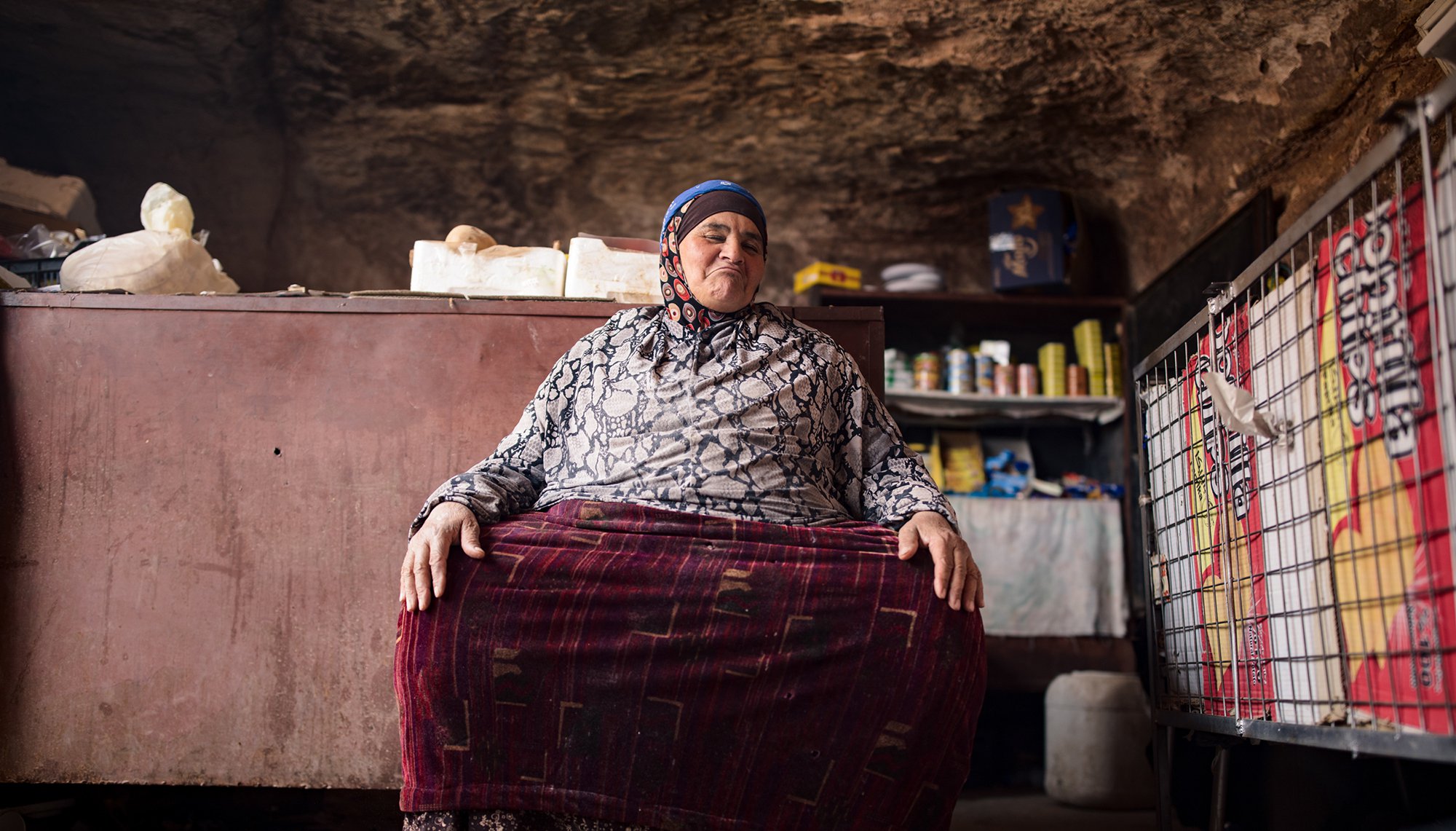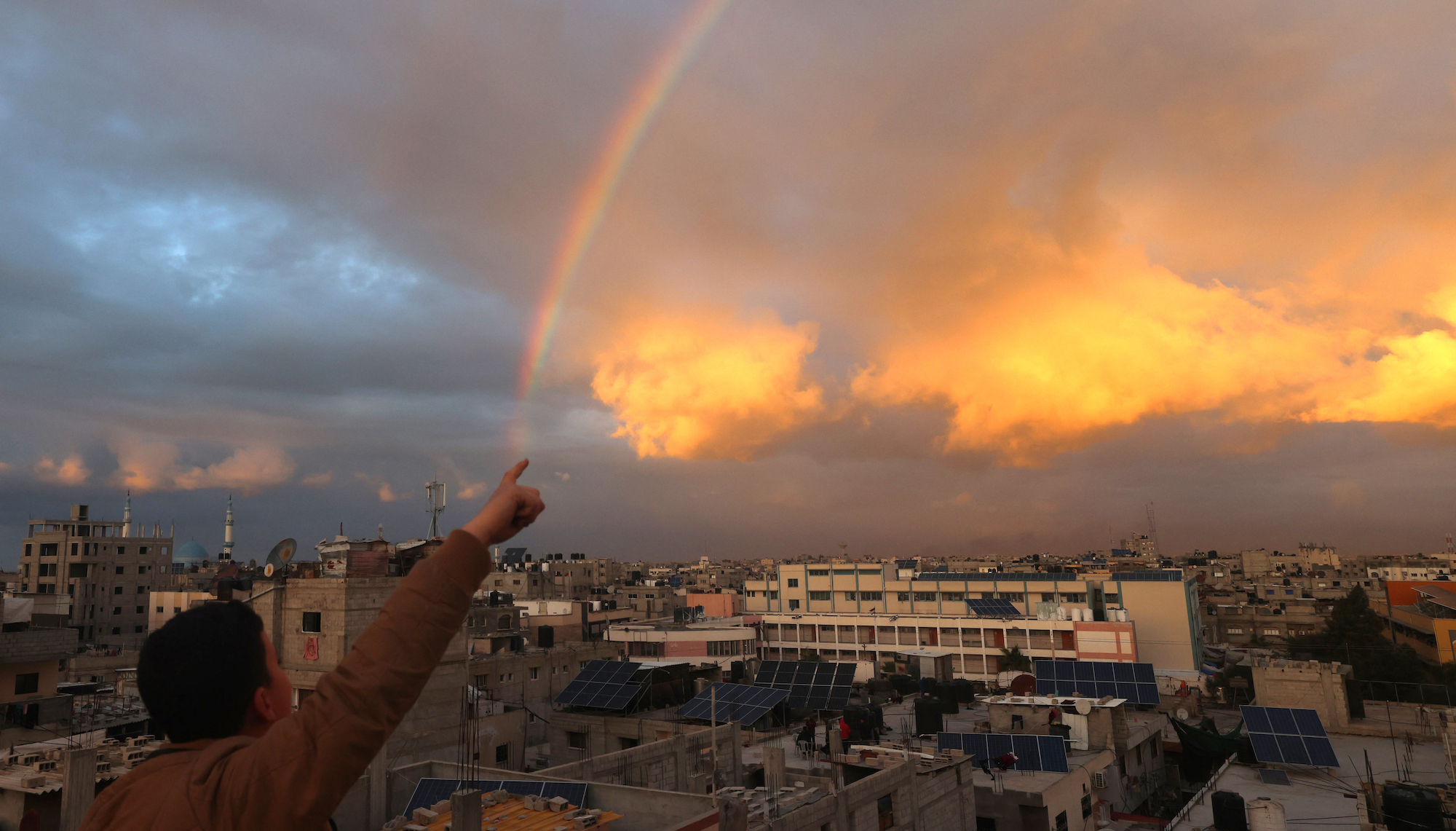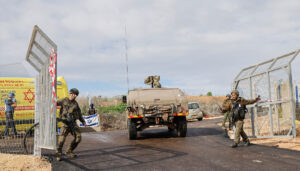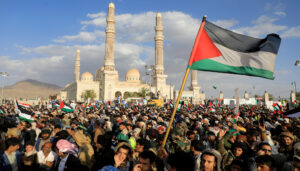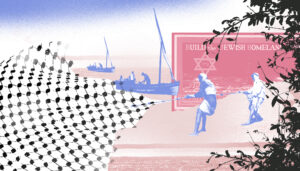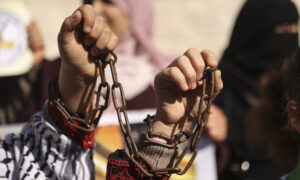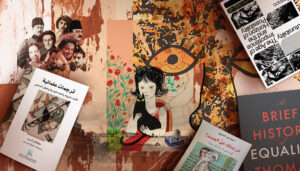The first time Layla Abu Saksuka ever saw a cave in her life was as her husband led her to one in the foothills of the Petra mountains. This place, he told her, would be her home from here on out.
That was 38 years ago. Layla was a bride at 20 years of age. She had just arrived from her village of Al Manawat in the Egyptian province of Giza. Once in Petra, her reception included five days of wedding celebrations honoring her and her Jordanian groom, Salama Abu Saksuka, who was 55 years her senior.
Layla had known that Salama had a wife in Jordan and adult children. She also knew that, six months prior, he had married another Egyptian woman, who then refused to accompany him back to Jordan. None of this stopped Layla; at the time, she had never once left the borders of her province. Travel excited her, even if it didn’t excite her family. “My family didn’t want him and I married him. They told me ‘don’t estrange yourself far away,’ but I said, no, this is my destiny. I want to go.”
A donkey was her method of transportation for the final leg of her journey from the village to Petra. Upon dismounting, she stood, astonished. She turned around, trying to absorb the fact that this little human settlement that she had suddenly descended into was indeed alive in the year 1981 — its men, women, children, goats, and chickens, all in the holes of the hills. From this moment on, she would be a part of it all. She collected herself and turned to her husband, saying “I want to go home.” His reply was calm: “there’s no going back.” It was at this moment that Layla stepped into the beginning of the rest of her life, which stretches up to this day. She would go on to become “Umm Abdullah,” a 58-year-old widow, mother of five children and grandmother of 13, who introduces herself via her deceased husband’s family name, speaking in an accent that retains only a faint shadow of Egypt.
For months after her arrival, Layla abstained from food. She wept all day and night and found it enormously difficult to perform even the simplest of tasks. While it is true that she came from a “peasant” environment, it was an environment that had offered a basic level of infrastructure and services. Now, instead of a gas oven, she had to search all over and gather wood to light a fire for the kitchen. In place of water from the tap, she woke up in the morning and escorted three mules carrying plastic jugs to the spring a half hour away from her cave. She would stand there and wait her turn in a queue of women, each coming with their mules, and then she turned to face another half hour hike back home.
On top of everything, Layla’s co-wife, as soon as Layla arrived, threw up her hands at the flock of goats that her husband owned — over 350 heads of livestock. She handed the work over to Layla. All these years later, Layla finds herself excusing her behavior. She was his cousin. She gave him eight children, and she spent nearly all her life raising them and his livestock, only to have him marry two other women over her in one blow. “She was more exhausted than everyone, including me. She was bringing in money, and then he went and married over her.”
Layla was a stranger in this land, alone without family. Given how difficult it was to make phone calls at that time, it was difficult to even keep in touch, nor did she have the right to complain about it, since her family was against this marriage from the start.
It took nearly six months for Layla to begin, little by little, accepting her reality and integrating herself into it. “‘Enough,’ I said. ‘This is my destiny.’ I was at peace with my destiny.” Things lightened up even more when her Egyptian co-wife arrived a few months after her; she would share in the tasks of caring for the livestock. Layla remembers the exact date of her arrival -October 6, 1981– because it was the night that Sadat was shot.
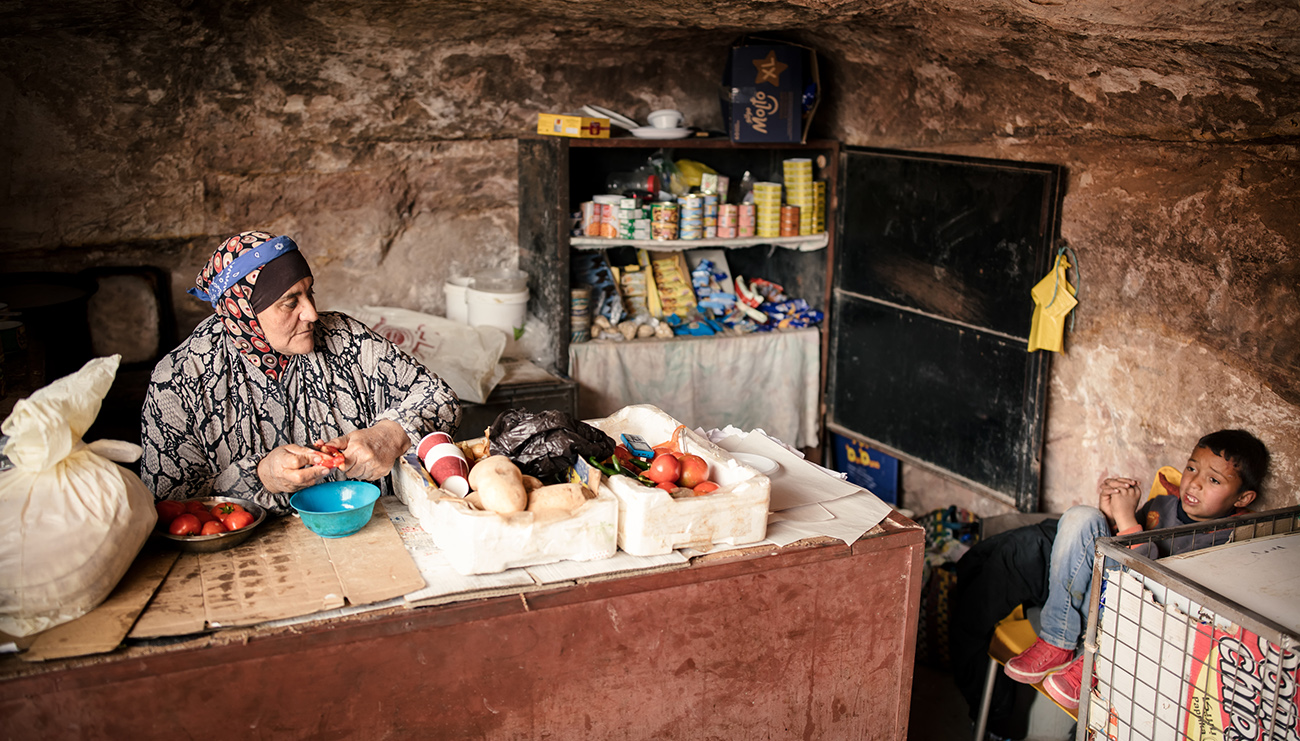
Layla at the rest area where she works.
Her husband worked at a rest area that sold drinks to tourists, while the three wives, each living with her children in a cave, oversaw domestic matters and herded the flock. Their day began with waking at dawn, then entering the frenzied cycle of flour and bread and cooking and milk and churning and chopping wood. Plus, of course, herding the livestock. Layla remembers climbing the mountains with the herd and gathering firewood along the way, which she would carry as a bundle on top of her head when she walked back home at the end of the day. Less than two years later, she would give birth to her first daughter Hayat, whom she would lose soon after when she was just a child. During that period, Layla would carry her infant on her head instead of firewood. Layla returned to herding while she was still in her postpartum period; “I took the animals grazing when Hayat was just 14 days old. I would put her in a misfar.” She explained to me that a “misfar” was what most people today call a cradle; in her day, women would make them out of wool and use them to carry their infants on the tops of their heads.
After Hayat, who died before reaching the age of two, Layla gave birth to three sons and two daughters. The first two births were in the cave, with the help of a midwife named Hamda. The rest of the children she gave birth to in Ma’an hospital, since they arrived after the family had left to the village of Umm Sayhoun. The village was a settlement of 122 residents and was built by the government for the families of the caves; Layla’s family moved there in 1985.
During all of her pregnancies, Layla says that she stayed at work right up until mere hours prior to giving birth. “I was herding the sheep, milking, cleaning on my hands and knees, fetching water. So when the pain began, I didn’t think that it was the pain of childbirth. I just thought that it was the pain of work.”
As the years passed, Layla learned to do many new things from those around her, and she taught them other skills in turn. She is proud of the dishes that she added to the family diet, which she saw lacking at the time, almost exclusively rashuf[1] and jarish[2] and shrak bread[3] and fat and butter. “The year that I came, they were stuck on chai and hot shrak bread. Enough with this breakfast! Rashuf at noon, and at night, if anyone had mansaf[4], all the people went over to eat dinner with them.”
Layla speaks with pride when she says that she taught them to grill like in Egypt, and to fold the malfuf[5] that she had originally found them dicing and frying with tomato and onion. Likewise, she taught them to make date cakes and a traditional type of cake made in a tabun oven[6].
In return, they taught her to make bread and lazakiat [a local dessert]. “And I learned to milk and churn and to make jameed and saman baladi [ghee].” She says that she also learned natya’ (loom weaving, in the local dialect). Thus she made rugs and bags that she would sell to tourists, “and, for my children, I made blankets, with which I would wrap them with after I gave birth.”
Over the last 38 years, Layla did visit her family in Egypt, every once and awhile. Year after year, her accent transformed, getting closer and closer to the Petra Bedouin dialect, so much so that when she visited Egypt, her Egyptian family would say “we need a translator to understand you!”
The longest period she spent without a visit was the period following her mother’s death in 1986. The first time she visited, after her father remarried, Layla says that she was shocked to see another woman living in her mother’s house, wearing her gold. “I had a psychological complex surrounding this matter, and I said ‘enough is enough. I don’t go to Egypt anymore.’” She stayed away for 14 years, and in Egypt, they told each other “oh, I hear she died.”
Layla’s family, like most families with livestock, did not cut ties to the caves, even after they left for Umm Sahyoun. The new condominiums were narrow, tight spaces — the area of one was not over 40 meters squared, standing upon property less than 400 meters squared overall. There just wasn’t space, certainly not for a flock of hundreds of heads of sheep and goats, as was the case for her husband. Even retaining a few heads of livestock was hard in the near-together houses, because of “the smell and the gnats and the bitter cold.” The situation in Petra had been opposite; Petra had vast expanses on which to live and store livestock. For this reason, Layla’s family remained tucked away in their caves in Petra, and she continued raising her sheep and goats, which, many nights, would sleep with her in the cave.
As mentioned above, the new houses were very small. Thus, “anyone with two pennies to rub together was building.” On a plot adjacent to the condo, her husband built an additional room, that way each woman could live in her own room with her children. Layla remembers that year as the beginning of a transformation in domestic diet, for their family and for others. They had had enough with baking, since their exertion in building placed an additional burden on their pre-existing daily obligations. Thus they turned to white bread, which they fetched from the nearby bakeries in Wadi Musa. It was the first time in their lives they were eating it. Before, when they resided primarily in the caves, says Layla, children would sometimes come down from the archaeological park[7] holding white bread that the tourists had given them. Back then, “we soaked it in water and gave it to the chickens.”
Before Umm Sahyoun, Layla says that there were no nearby stores, so people would sometimes fetch their things from the stores in Wadi Musa. In general, they didn’t need more than that; the families of the caves made nearly everything necessary to sustain themselves. They made their own munah[8] out of fat and jameed[9] and eggs from chickens they raised. They ate from the vines of pomegranate plants, grapes, and berries, which grew around the water springs of As-Siq and Abu Aleeqa. “Each one of us had a small garden plot,[10] and we grew a small amount of tomato and zucchini.”
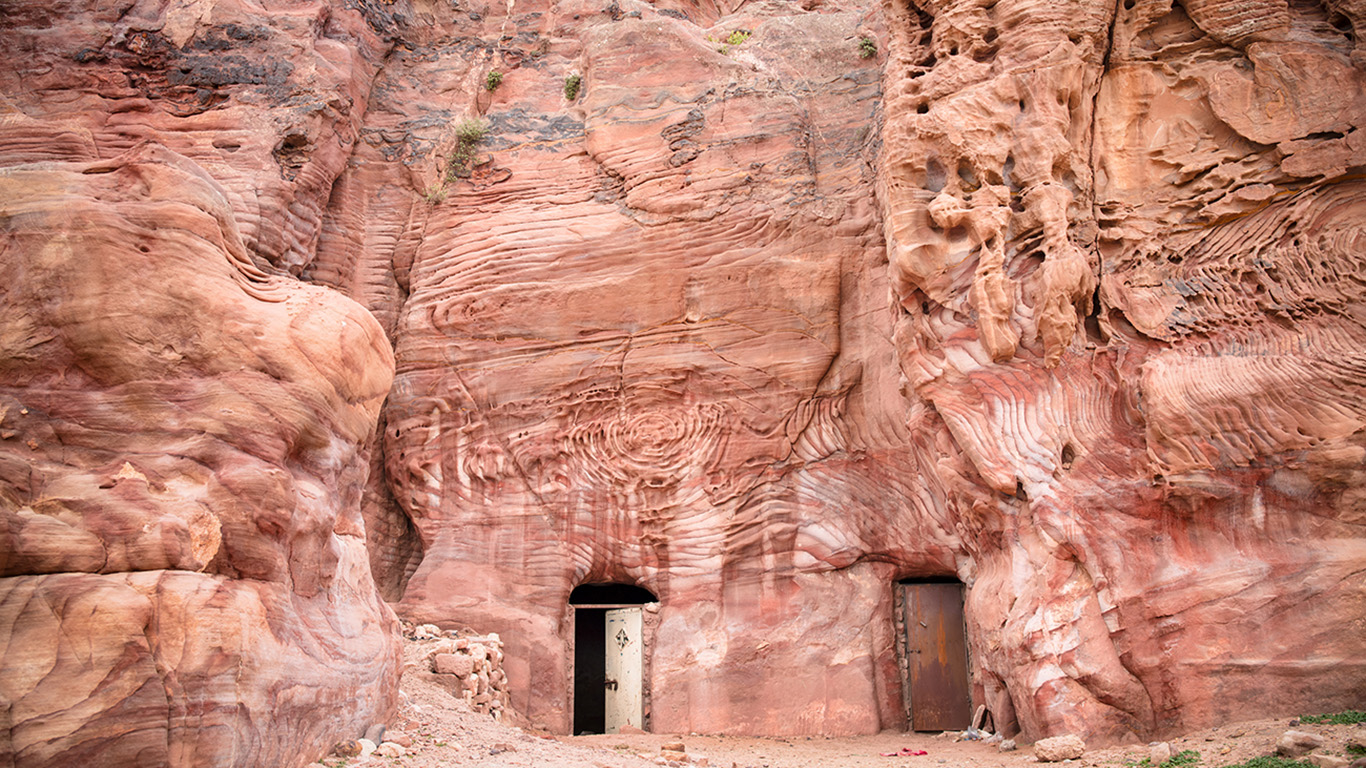
The cave in which Layla lived when she got married, and in which she spends most winters.
Additionally, says Layla, they had the wheat they grew on the plateaus of the Prophet Aaron. Today, very few people grow wheat, since they have become primarily occupied by agriculture for tourism. The few that continue to grow wheat do it not for harvest, but so that they can graze their livestock on it in the spring. Today’s wheat is shorter, even, as the rains do not come like they used to. In years past, Layla says, wheatstalks grew to the height of a child.
Layla’s husband died 20 years ago. All of a sudden, she had found herself a widow at 38, forced to take over the responsibility of providing for her five children. The oldest was 15 years in age, and the smallest was four. She vehemently refused to delve into the details of this obligation during our talks. She would respond to all questions pertaining to this topic with one phrase alone: “Thanks be to God. What’s important is that my children live in peace.”
After her husband died, she turned from working with the flock to working with shrak bread. Every day she made nearly 300 loaves and distributed them to the stores with which she had a contract. “I would get up at five in the morning after dawn prayers, knead, cook, and send to the store. And afterwards, I would knead, cook, and send to the second store.” She baked for the mansafs at wedding parties and was hired also by tourism event organizations in the area.
Then, however, she left Shrak, four years later. Her knees had become worn from sitting for long hours, kneading and baking a flour-sack’s-worth of bread each day. Besides, lots of people had entered that profession. So she left baking behind and worked seven years as a cleaner with a private company inside the archaeological park. Afterwards, she left that work and opened a small store on the way to the Petra Monastery[11] to sell souvenirs, which her children would bring in from Amman. She left this work, too, after a few years. “I was becoming tired of the Monastery stairs, up and down, and I am afraid of riding a donkey.”
Three years ago, Layla opened a rest stop at a cave where she offers food to workers — tomato stews, beans, hummus, egg and cheese sandwiches, and cold drinks. She prepared the place with a few furnishings and a woven mat so her customers have a place to sit while they eat. Her rest stop is a destination for dozens of people who come every day. They pay her not just in Jordanian Dinars, but in Dollars and Euros and other foreign currencies that they receive from tourists in exchange for their services. Layla can discern each currency and its value, and when she gathers enough, she goes to exchange the money at the bank.
In her hometown, Layla owns land that she inherited from her father, and her nieces and nephews took on the task of investing it for her. She hopes to return to retire in Egypt. When she visits, her relatives there treat her as a respected elder, a sheikha[12]. In this stage of her life, Layla could retire, but instead, she sticks to her decision to be near her children and grandchildren. Her two daughters have married; one lives in Umm Sayhoun, and the other lives in the U.S. Her eldest son works in a lookout in the archaeological park, and the other works in cultural heritage restoration. Her youngest, Hamad, now 24 years old, works in the archaeological park on a mule. A year ago, he married a Danish girl who works as a tour guide there. He met her when she came with her group to Layla’s rest stop; the two of them now split their time between Denmark and Jordan.
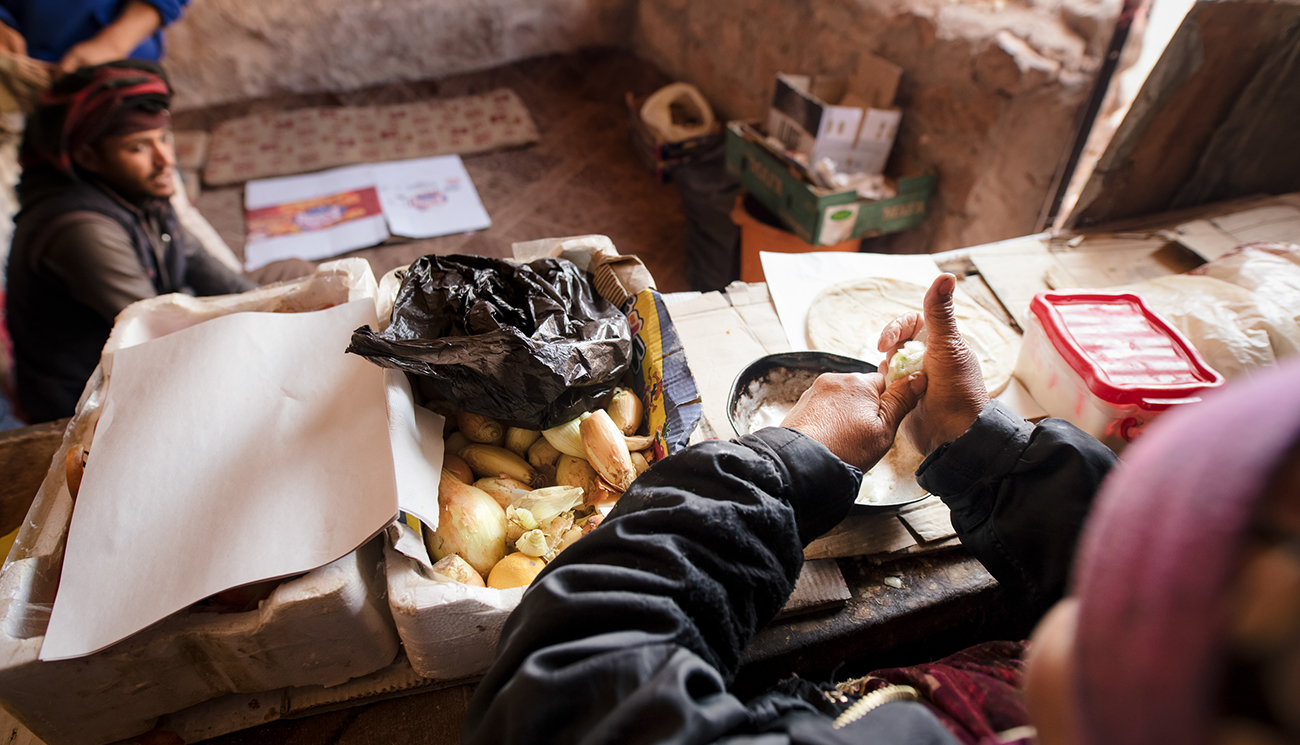
Layla at the rest area.
Ironically, the biggest tragedy of Layla’s life was supposed to have come to a close with her move to a house of cement four years after her marriage. However, she ultimately preferred life in the cave over life in the condos. She says that she can’t stand the commotion in Umm Sayhoun, nor the feeling of being boxed inside its houses. “I love living in the cave. I don’t want noise and annoyances and movement. I want calm.”
After her husband’s passing, she originally wanted to return to permanent residency in the cave, but she was kept in Umm Sayhoun by her aspirations for her children. They were still in school, and she didn’t want them to suffer from the daily trek to the schoolhouse. Only in the last ten years, after marrying away her last daughter, did she feel she took hold of her freedom. She only goes to Umm Sayhoun, where her children still live, when the heat gets extreme in the summer, just so she can use the air conditioner. She spends the entire winter in the cave where she married, which now has a small camp erected inside. She says that it’s much warmer than the Umm Sayhoun houses, which stand exposed to the bitter cold.
She doesn’t have electricity in the cave now, but she plans to set up solar panels after Ramadan so she can stay up later at night. “I have neighbors in the cave, and my children come, and we do dinner and stay up talking and laughing and then fall asleep there together.”
Layla says that she will stay working at the rest stop as long as she can stand on her own two feet. Nearly all her guests are returning customers; they know the place well. She folds a sandwich while one customer asks after her family. Another tells a story of giving away his donkey, which had been complaining and refusing to walk, only to discover that with its new owner, it walked all the way to the View and the Visitor’s Center! She jokes with a young man who does impressions of the actor Johnny Depp as Jack Sparrow, his hair grown out and eyes outlined with thick kohl.[13] It’s only to solicit tourists, she says jestingly. Then, she turns to address the unknown stranger whom she happens to find as a customer in the rest stop that day. She says, in a knowing tone, “these young ones, I know them, from before. These are my children.”
-
References
[1] Rashuf is a traditional bedouin soup typically composed of lentils and chickpeas.
[2] Jarish is a traditional bedouin dish based around ground wheat.
[3] Shrak or shrak bread forms the basis of much Middle Eastern cuisine and is unleavened, often used to dip or wrap other foods.
[4] Mansaf is a dish of rice and lamb that comes from bedouin culture and has become a national symbol of Jordanian culture and heritage. It is often served at special occasions and social functions, such as weddings, engagements, or when hosting guests.
[5] Malfuf literally means “wrap” or “that which is folded” and can refer to a variety of specific dishes. Often it refers to cabbage rolls/stuffed cabbage.
[6] A tabun oven is a small clay oven common to the Middle East. Today it may also be made out of metal.
[7] The archaeological park is a term used in reference to the ancient city of Petra, a site curated and maintained for its touristic value and archaeological research.
[8] Across the Levantine region, munah refers to non-perishables goods made seasonally and kept in the home, to last until the next annual production season.
[9] Jameed refers to a dairy-based drink common in Jordanian culture.
[10] The original Arabic version of this article here uses a bedouin term for a small plot of land used for personal agriculture.
[11] A site in the archaeological park frequented by tourists.
[12] “Sheikh” (or “sheikha” for women) is an Arabic term used to describe an elder member of society whose life experience and age confers upon them a measure of deserve respect and admiration. There are also religious resonances of the term within Islamic practices.
[13] Kohl is a cosmetic the color of black used to darken eyelids and eyelashes. It is worn throughout a many cultures in the Arab world as well as other places in Africa, the Mediterannean, and the Indian subcontinent. It is used by men and women and is seen to have protective properties from the sun.
